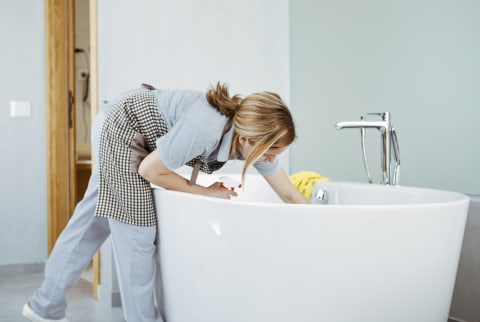Advertisement
I'm A Mold Remediation Expert & These Are 5 Mold Myths I Hear All The Time


Over the years as a mold remediation expert, I've realized that there is a lot of misinformation out there about mold and how to properly treat it in order to prevent health issues. In my conversations with people who suffer from mold at home, here are the common myths that I hear time and time again:
Myth 1: If you dry out the space, the mold goes away.
Mold needs water to thrive. But a common misconception is that when you dry out a space, mold simply goes away. In reality, dry mold doesn't die; it becomes dormant.
Dormant mold can then get brittle and easily break off into small particles that become airborne in your home, where it can spread through your HVAC system. From there, it will wait dormant for the right environment to grow again. So while it may not be producing as much contamination in the air, this dormant mold is still a source of concern.
The EPA notes that it is not enough to just kill mold1. It must be removed, as dead (or dormant) mold can still cause allergic reactions in people.
Myth 2: Spraying bleach on mold will eliminate it.
Another common misconception is that spraying mold with bleach will kill it. This couldn't be further from the truth. Again, when remediating mold, the focus should be on removing mold, not killing it.
Spraying bleach on mold does not do a good job of removing it; it simply discolors it. A background level of mold will remain. Additionally, long exposure to chlorine bleach only makes air quality worse and could potentially cause symptoms like blurred vision, watery eyes, difficulty breathing, and nausea, among others.
Myth 3: Mold takes a long time to grow.
This myth is really common, and I often hear that mold can take weeks to grow. In reality, mildew and mold will develop within 24 to 48 hours of water exposure. It will also continue to grow until mitigation steps are taken to eliminate the source of moisture. This is why promptly addressing the source of moisture is imperative for controlling mold growth.
Myths 4 & 5: Wiping mold away will eradicate it, and fogging alone will eliminate mold.
In my mind, these two myths go hand-in-hand. They are both extremely common in old-school mold remediation tactics, and I've encountered lots of people who've had mold remediation done in their homes by companies who only perform "demolition-free mold remediation" through a "surface wipedown" or a "dry fogging" process (which involves spraying an antimicrobial pesticide on to mold in order to kill it).
While it may seem attractive to spend less on a wipe-down or fogging remediation, it won't be money well spent when the mold comes back.
The issue here is that by the time you notice mold on a surface, it's already more widespread than what the eye can see. Wiping away mold from a surface like drywall will give you a false sense of security that you've eliminated your mold issue. In reality, mold has a roots-like system, called hyphae2, which physically grows into porous building materials such as drywall or insulation. When you wipe away mold from the surface, you're not necessarily removing the hyphae from the building material. This will result in the mold growing back again.
The bottom line.
All of these myths speak to the same idea: Removing mold is like removing a weed. If you just remove the visible parts of it, it will grow back. In order to properly remove it, you have to get down to those roots.
You'll need a professional to completely remove mold from your home, but you can keep it from forming in the first place with these tips. (They're pegged to the summer months, but applicable all year round.)